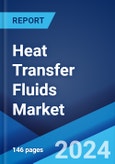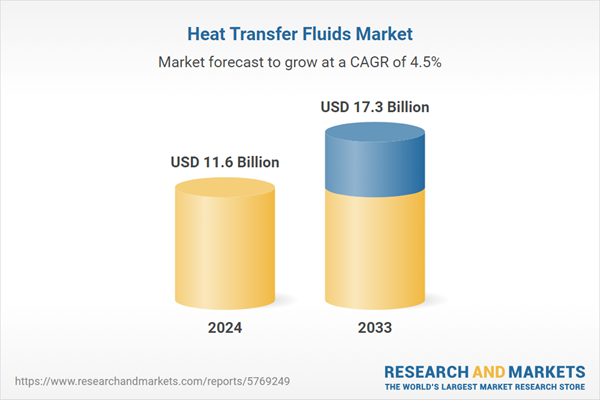Heat transfer fluids (HTFs), or thermic fluids, refer to chemicals in liquid or vapor form that transfer heat from one system to another. They are manufactured using highly refined petroleum, synthetically formulated hydrocarbons, or silicone. They are mainly employed as an intermediate fluid to transmit heat from a heat source to other heat demands or cold streams. They assist in preventing overheating and facilitate the storage of thermal energy. They also offer high temperatures at low system pressures and provide several benefits, such as low viscosity, non-corrosive nature, high thermal conductivity and diffusivity, and prolonged operating lifetimes. As a result, HTFs find extensive applications in the reboiler, condenser, regenerator, and heat exchanging systems across the processing facilities of numerous industries, including oil and gas, automotive, chemical, renewable energy, and pharmaceutical.
Heat Transfer Fluids Market Trends:
HTFs aid in collecting energy from the solar field and transporting it to the energy storage systems, wherein the stored energy is used for electricity generation. Consequently, the increasing adoption of concentrated solar power (CSP) plants represents the primary factor driving the market growth. Additionally, there is a rise in the use of HTFs during various stages of natural gas processing, such as gas sweetening, glycol dehydration, and fractionation. In line with this, the growing product utilization in the refining processes as a medium for heating reboilers of fractionation units and overhead cooling condensers has augmented the demand for HTFs. This is further supported by rapid growth in the oil and gas sector due to the escalating energy demand. Besides this, the increasing usage of HTFs in heating and cooling applications at food processing facilities for food additive manufacturing, vegetable oil deodorizing, and food packaging production has catalyzed market growth. Furthermore, there has been widespread adoption of HTFs as heat-dissipating coolant fluid in the radiator systems of vehicle engines. Along with this, the rising product usage in the chemical sector for indirect heating of process liquids and polymers, single fluid batch processing, low-pressure cogeneration, drying and heating of bulk materials, and gas processing has propelled the market growth. Other factors, including the growing need for energy conservation, increasing product applications in HVAC and refrigeration systems, escalating automobile production and sales, and rising government funding for CSP plants, are also creating a favorable market outlook.Key Market Segmentation:
The publisher provides an analysis of the key trends in each segment of the global heat transfer fluids market, along with forecasts at the global, regional, and country levels from 2025-2033. Our report has categorized the market based on type and end user.Type Insights:
- Mineral Oils
- Synthetic Fluids
- Glycols
- Others
End User Insights:
- Chemical
- Oil and Gas
- Food and Beverages
- Pharmaceutical
- Renewable Energy
- Automotive
- HVAC and Refrigeration
- Others
Regional Insights:
- North America
- United States
- Canada
- Asia-Pacific
- China
- Japan
- India
- South Korea
- Australia
- Indonesia
- Others
- Europe
- Germany
- France
- United Kingdom
- Italy
- Spain
- Russia
- Others
- Latin America
- Brazil
- Mexico
- Others
- Middle East and Africa
Competitive Landscape:
The report has also provided a comprehensive analysis of the competitive landscape in the global heat transfer fluids market. Competitive analysis such as market structure, market share by key players, player positioning, top winning strategies, competitive dashboard, and company evaluation quadrant has been covered in the report. Also, detailed profiles of all major companies have been provided. Some of the companies covered include Arkema S.A., BASF SE, Chevron Corporation, Clariant AG, Dalian Richfortune Chemicals Co. Ltd., Dow Inc., Dynalene Inc., Eastman Chemical Company, Exxon Mobil Corporation, Hindustan Petroleum Corporation Ltd. (Oil and Natural Gas Corporation), Indian Oil Corporation Ltd., Phillips 66 Company, Radco Industries Inc., Shell plc, TotalEnergies SE, etc.Key Questions Answered in This Report:
- How has the global heat transfer fluids market performed so far, and how will it perform in the coming years?
- What are the drivers, restraints, and opportunities in the global heat transfer fluids market?
- What is the impact of each driver, restraint, and opportunity on the global heat transfer fluids market?
- What are the key regional markets?
- Which countries represent the most attractive heat transfer fluids market?
- What is the breakup of the market based on the type?
- Which is the most attractive type in the heat transfer fluids market?
- What is the breakup of the market based on the end user?
- Which is the most attractive end user in the heat transfer fluids market?
- What is the competitive structure of the global heat transfer fluids market?
- Who are the key players/companies in the global heat transfer fluids market?
Table of Contents
Companies Mentioned
- Arkema S.A.
- BASF SE
- Chevron Corporation
- Clariant AG
- Dalian Richfortune Chemicals Co. Ltd.
- Dow Inc.
- Dynalene Inc.
- Eastman Chemical Company
- Exxon Mobil Corporation
- Hindustan Petroleum Corporation Ltd. (Oil and Natural Gas Corporation)
- Indian Oil Corporation Ltd.
- Phillips 66 Company
- Radco Industries Inc.
- Shell plc
- TotalEnergies SE
Methodology

LOADING...
Table Information
| Report Attribute | Details |
|---|---|
| No. of Pages | 140 |
| Published | March 2025 |
| Forecast Period | 2024 - 2033 |
| Estimated Market Value ( USD | $ 11.6 Billion |
| Forecasted Market Value ( USD | $ 17.3 Billion |
| Compound Annual Growth Rate | 4.5% |
| Regions Covered | Global |
| No. of Companies Mentioned | 15 |









